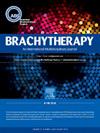Definitive treatment for primary urethral cancer: A single institution's experience with organ-preserving brachytherapy
IF 1.7
4区 医学
Q4 ONCOLOGY
引用次数: 0
Abstract
BACKGROUND
Radical urethectomy ± cystectomy has long represented the standard of care for rare primary urethral cancer (PUC). With our analysis, we want to demonstrate the efficacy and safety of brachytherapy (BT) of urethra for organ preservation.
MATERIALS AND METHODS
We analyzed treatment procedures and results of 3 patients with PUC, which have been treated in our department between 2011 and 2020 with brachytherapy. One male patient underwent brachytherapy with chemoradiotherapy after transurethral resection (TUR). Brachytherapy has been performed as high-dose-rate (HDR) boost with a cumulative dose of 8 Gy (9.3 Gy EQD2-α/β = 10 Gy). The 2 further female patients have been treated with sole pulsed-dose-rate (PDR) brachytherapy with a total dose of 49.9 Gy (50.3 Gy EQD2-α/β = 10 Gy) and 62.2 Gy (64.6 Gy EQD2-α/β = 10 Gy).
RESULTS
Median follow-up was 103 months (41–153). No local recurrence occurred and all patients are still alive. For the male patient we documented Grade 3 cystitis. As late side effects the pre-existing Grade 2 incontinence worsened to Grade 3. Among female patients one developed Grade 3 vaginal synechiae. There was no Grade ≥4 toxicity.
CONCLUSION
Brachytherapy in PUC is a feasible and promising option with high local control rate and tolerable toxicity. It provides a good alternative to surgery for organ preservation in selected patients.
原发性尿道癌的确定性治疗:一家医疗机构使用保留器官近距离放射治疗的经验。
背景:长期以来,根治性尿道切除术和膀胱切除术一直是罕见原发性尿道癌(PUC)的标准治疗方法。通过分析,我们希望证明尿道近距离放射治疗(BT)在保留器官方面的有效性和安全性:我们分析了 2011 年至 2020 年期间在我科接受近距离放射治疗的 3 例 PUC 患者的治疗过程和结果。其中一名男性患者在经尿道切除术(TUR)后接受了近距离放射治疗和化疗。近距离放射治疗采用高剂量率(HDR)增强疗法,累积剂量为 8 Gy(9.3 Gy EQD2-α/β = 10 Gy)。另外两名女性患者接受了单脉冲剂量率(PDR)近距离放射治疗,总剂量分别为49.9 Gy(50.3 Gy EQD2-α/β = 10 Gy)和62.2 Gy(64.6 Gy EQD2-α/β = 10 Gy):中位随访时间为 103 个月(41-153 个月)。没有发生局部复发,所有患者均健在。男性患者的膀胱炎达到了 3 级。作为晚期副作用,原有的 2 级尿失禁恶化为 3 级。女性患者中有一人出现了 3 级阴道挛缩。没有≥4级的毒性反应:结论:近距离放射治疗 PUC 是一种可行且前景广阔的选择,具有较高的局部控制率和可耐受的毒性。结论:近距离放射治疗 PUC 是一种可行且有前途的选择,局部控制率高,毒性可耐受,是经选择的患者保留器官手术的良好替代方案。
本文章由计算机程序翻译,如有差异,请以英文原文为准。
求助全文
约1分钟内获得全文
求助全文
来源期刊

Brachytherapy
医学-核医学
CiteScore
3.40
自引率
21.10%
发文量
119
审稿时长
9.1 weeks
期刊介绍:
Brachytherapy is an international and multidisciplinary journal that publishes original peer-reviewed articles and selected reviews on the techniques and clinical applications of interstitial and intracavitary radiation in the management of cancers. Laboratory and experimental research relevant to clinical practice is also included. Related disciplines include medical physics, medical oncology, and radiation oncology and radiology. Brachytherapy publishes technical advances, original articles, reviews, and point/counterpoint on controversial issues. Original articles that address any aspect of brachytherapy are invited. Letters to the Editor-in-Chief are encouraged.
 求助内容:
求助内容: 应助结果提醒方式:
应助结果提醒方式:


